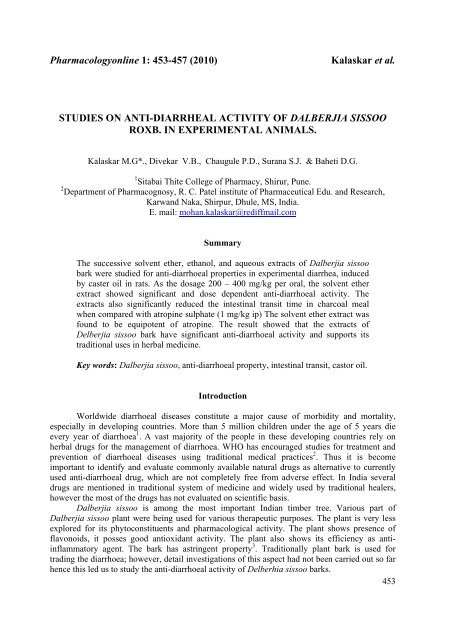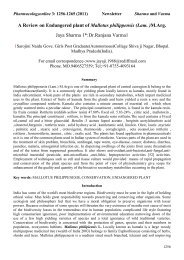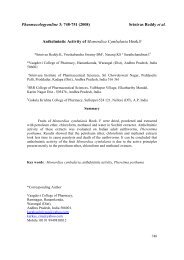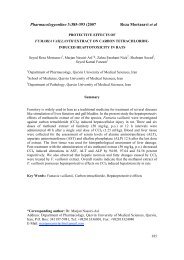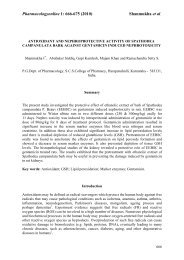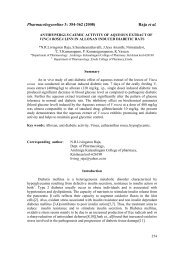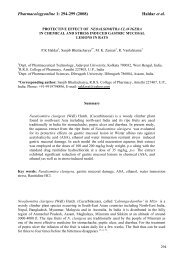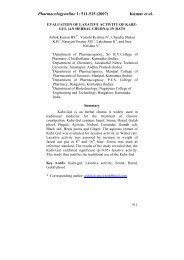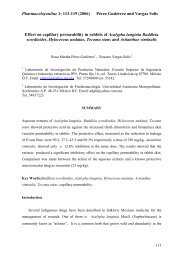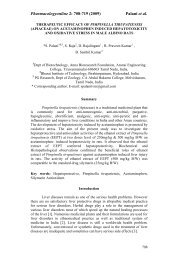Studies on Anti-Diarrheal Activity of Dalberjia ... - Pharmacologyonline
Studies on Anti-Diarrheal Activity of Dalberjia ... - Pharmacologyonline
Studies on Anti-Diarrheal Activity of Dalberjia ... - Pharmacologyonline
Create successful ePaper yourself
Turn your PDF publications into a flip-book with our unique Google optimized e-Paper software.
Pharmacology<strong>on</strong>line 1: 453-457 (2010) Kalaskar et al.<br />
STUDIES ON ANTI-DIARRHEAL ACTIVITY OF DALBERJIA SISSOO<br />
ROXB. IN EXPERIMENTAL ANIMALS.<br />
Kalaskar M.G*., Divekar V.B., Chaugule P.D., Surana S.J. & Baheti D.G.<br />
1 Sitabai Thite College <strong>of</strong> Pharmacy, Shirur, Pune.<br />
2 Department <strong>of</strong> Pharmacognosy, R. C. Patel institute <strong>of</strong> Pharmaceutical Edu. and Research,<br />
Karwand Naka, Shirpur, Dhule, MS, India.<br />
E. mail: mohan.kalaskar@rediffmail.com<br />
Summary<br />
The successive solvent ether, ethanol, and aqueous extracts <strong>of</strong> <strong>Dalberjia</strong> sissoo<br />
bark were studied for anti-diarrhoeal properties in experimental diarrhea, induced<br />
by caster oil in rats. As the dosage 200 – 400 mg/kg per oral, the solvent ether<br />
extract showed significant and dose dependent anti-diarrhoeal activity. The<br />
extracts also significantly reduced the intestinal transit time in charcoal meal<br />
when compared with atropine sulphate (1 mg/kg ip) The solvent ether extract was<br />
found to be equipotent <strong>of</strong> atropine. The result showed that the extracts <strong>of</strong><br />
Delberjia sissoo bark have significant anti-diarrhoeal activity and supports its<br />
traditi<strong>on</strong>al uses in herbal medicine.<br />
Key words: <strong>Dalberjia</strong> sissoo, anti-diarrhoeal property, intestinal transit, castor oil.<br />
Introducti<strong>on</strong><br />
Worldwide diarrhoeal diseases c<strong>on</strong>stitute a major cause <strong>of</strong> morbidity and mortality,<br />
especially in developing countries. More than 5 milli<strong>on</strong> children under the age <strong>of</strong> 5 years die<br />
every year <strong>of</strong> diarrhoea<br />
453<br />
1 . A vast majority <strong>of</strong> the people in these developing countries rely <strong>on</strong><br />
herbal drugs for the management <strong>of</strong> diarrhoea. WHO has encouraged studies for treatment and<br />
preventi<strong>on</strong> <strong>of</strong> diarrhoeal diseases using traditi<strong>on</strong>al medical practices 2 . Thus it is become<br />
important to identify and evaluate comm<strong>on</strong>ly available natural drugs as alternative to currently<br />
used anti-diarrhoeal drug, which are not completely free from adverse effect. In India several<br />
drugs are menti<strong>on</strong>ed in traditi<strong>on</strong>al system <strong>of</strong> medicine and widely used by traditi<strong>on</strong>al healers,<br />
however the most <strong>of</strong> the drugs has not evaluated <strong>on</strong> scientific basis.<br />
<strong>Dalberjia</strong> sissoo is am<strong>on</strong>g the most important Indian timber tree. Various part <strong>of</strong><br />
<strong>Dalberjia</strong> sissoo plant were being used for various therapeutic purposes. The plant is very less<br />
explored for its phytoc<strong>on</strong>stituents and pharmacological activity. The plant shows presence <strong>of</strong><br />
flav<strong>on</strong>oids, it posses good antioxidant activity. The plant also shows its efficiency as antiinflammatory<br />
agent. The bark has astringent property 3 . Traditi<strong>on</strong>ally plant bark is used for<br />
trading the diarrhoea; however, detail investigati<strong>on</strong>s <strong>of</strong> this aspect had not been carried out so far<br />
hence this led us to study the anti-diarrhoeal activity <strong>of</strong> Delberhia sissoo barks.
Pharmacology<strong>on</strong>line 1: 453-457 (2010) Kalaskar et al.<br />
Methods<br />
Plant material: Bark <strong>of</strong> <strong>Dalberjia</strong> sissoo were collected from Shirur, in the m<strong>on</strong>th <strong>of</strong> June 2007.<br />
A voucher specimen has been deposited at C. T. Bora College, Shirur, Pune and authenticated.<br />
The plant bark were cleaned, washed, dried under shade, dried material were coarsely powdered.<br />
The 500gm <strong>of</strong> powdered material was extracted by successive extracti<strong>on</strong> process using soxhlet<br />
apparatus with different solvent in increasing order <strong>of</strong> polarity such as solvent ether, ethanol and<br />
water. The extracts were c<strong>on</strong>centrated under vacuum and residues were used for experiment<br />
purpose. The percent extract found 1.62%w/w, 5.98%w/w and 6.93%w/w respectively.<br />
Phytochemical screening: The freshly prepared extracts were subjected for preliminary<br />
phytochemical study for identificati<strong>on</strong> <strong>of</strong> different phytoc<strong>on</strong>stituents. The aqueous extract<br />
shown the presence <strong>of</strong> carbohydrates, Tannins and sap<strong>on</strong>ines. The ethanol extract shows<br />
presence <strong>of</strong> flav<strong>on</strong>oids, tannins, terpenoids and alkaloids, while solvent ether extract c<strong>on</strong>tains<br />
fixed oil alkaloids, terpenoids and sap<strong>on</strong>ines 4 .<br />
Animals: Albino Swiss rat <strong>of</strong> either sex weighing 150-180 g were used for castor oil induced<br />
diarrhoea and intestinal transit activity. All animals were fed standard fed and tap water ad<br />
libitium before the experiment. Each animal group c<strong>on</strong>sist <strong>of</strong> six animals housed in separate<br />
cadge.<br />
Acute Toxicity: Acute toxicity was performed according to the OECD-423 guide lines. Swiss<br />
mice (20 – 25 g) <strong>of</strong> either sex were used. The animals were administered with distilled water (10<br />
ml/kg), the vehicle or different extract (1 - 5 g/kg) <strong>of</strong> <strong>Dalberjia</strong> sissoo bark orally (p.o). The<br />
animals were observed for 6 h within the first 24 h, then for further 14 days for deaths and<br />
manifestati<strong>on</strong> <strong>of</strong> toxic effects. The toxic effects observed included agility, muscular t<strong>on</strong>us,<br />
tremors, and c<strong>on</strong>vulsi<strong>on</strong>s, breathing patterns, water and food intake. When no mortality was<br />
observed, the procedure was repeated up to the highest dose <strong>of</strong> 5 g/kg.<br />
Caster oil induced diarrhea: The 18 hr fasted albino rats <strong>of</strong> either sex 150-200gm are divided<br />
into 8 groups six each. One ml <strong>of</strong> caster oil was given to the group 1 orally and serves as c<strong>on</strong>trol.<br />
While group 2 received loperamide (1mg/kg) as standard. solvent ether extract at dose <strong>of</strong> 200<br />
and 400mg/kg was administered to group 3 and 4 respectively. Alcoholic extract at 200-<br />
400mg/kg was administered to group 5 and 6 respectively and aqueous extract at as dose 200-<br />
400mg/kg was administered to group 7 and 8 respectively. One hour after treatment, each rat<br />
received 1ml <strong>of</strong> castor oil orally and then observed for defecati<strong>on</strong> up to 4hr. after treatment<br />
castor oil challenge. The presences <strong>of</strong> characteristic wet and dry diarrhoeal dropping were noted<br />
<strong>on</strong> n<strong>on</strong>-wetting paper sheet <strong>of</strong> uniform weight for period <strong>of</strong> 4 hr 5 . (Table 1.)<br />
Gastrointestinal motility test: Animals fasted for 18 h prior to the experiment with tap water ad<br />
libitum were randomly divided into five groups <strong>of</strong> six animals each. Each rat was administered<br />
orally with 1ml <strong>of</strong> charcoal meal (3% deactivated charcoal in 2 % aq. gum acacia). Group 1<br />
received vehicle (0.2ml, 2% w/v aq. gum acacia) and serves as c<strong>on</strong>trol. Group 2 treated with<br />
Atropine (1mg/kg IP) as standard drug. The group 3, 4 and 5 received 400mg/kg <strong>of</strong> solvent ether,<br />
ethanol and aqueous extract respectively. Thirty min. later, each rat was scarified and intestinal<br />
distance moved by the charcoal meal from pylorus sphincter was measured and expressed as mean<br />
distance from pylorus to caecum 6 . (Table 2).<br />
454
Pharmacology<strong>on</strong>line 1: 453-457 (2010) Kalaskar et al.<br />
Results<br />
The castor oil induced diarrhoea:<br />
In castor oil induced diarrhoea experiment, the rat which doesn’t receive plant extracts<br />
and standard drug produced diarrhoea after 30 min. and c<strong>on</strong>tinue up to 4 hr. with sign <strong>of</strong> watery<br />
and frequent defecati<strong>on</strong>. All the extract <strong>of</strong> <strong>Dalberjia</strong> sissoo shows marked reducti<strong>on</strong> in number <strong>of</strong><br />
defecati<strong>on</strong> over four hours in dose dependent manner (p
Pharmacology<strong>on</strong>line 1: 453-457 (2010) Kalaskar et al.<br />
Table No. 2. Comparis<strong>on</strong> <strong>of</strong> Dalbergia sissoo Bark Extracts On Gastro-intestinal Motility.<br />
Treatment Dose (mg/kg)<br />
Mean Distance Traveled By<br />
Charcoal ±SEM<br />
C<strong>on</strong>trol (vehicle) - 84.3±3.67<br />
Atropine sulphate 1 21.0±1.84<br />
solvent ether extract 400 12.6±1.06<br />
Ethanolic extract 400 62.4±2.64<br />
Aqueous extract 400 41.1±2.15<br />
Values are mean ± SEM <strong>of</strong> six experiments.<br />
Discussi<strong>on</strong><br />
The diarrhea is mostly occurred as hypersecreti<strong>on</strong> <strong>of</strong> certain comp<strong>on</strong>ents or by hyper<br />
motility. The use <strong>of</strong> caster oil induced diarrhea model is logical, as caster oil hydrolyze to<br />
recinolic acid in duodenum, results in irritati<strong>on</strong> and inflammati<strong>on</strong> <strong>of</strong> intestinal mucosa, leads to<br />
release <strong>of</strong> autocoids and prostaglandins which stimulate motility and secreti<strong>on</strong>s 7-10 . In present<br />
study <strong>Dalberjia</strong> sissoo all the extracts significantly inhibited caster oil induced diarrhea in dose<br />
dependent manner, it can be assumed that the antidiarrhoeal acti<strong>on</strong> was exerted by anti-secretary<br />
mechanism, this can be evident by reducti<strong>on</strong> in total number <strong>of</strong> wet feces produced by test<br />
extract treated animals. The solvent ether and aqueous extract may increased the absorpti<strong>on</strong> <strong>of</strong><br />
water and electrolyte form gastrointestinal tract, because these increased the gastrointestinal<br />
transit time as compared to c<strong>on</strong>trol and atropine, they might have anti-motility property. The<br />
n<strong>on</strong>-polar and polar phytoc<strong>on</strong>stituent are resp<strong>on</strong>sible for anti-secretary and anti-motility<br />
property. The preliminary phytochemical investigati<strong>on</strong> shows the presence <strong>of</strong> alkaloids, steroids<br />
and sterols, sap<strong>on</strong>ins and fixed oils in solvent ether extract, while tannins, flav<strong>on</strong>oids, sap<strong>on</strong>ins<br />
and carbohydrates and proteins. earlier studies showed that anti-dysenteric and antidiarrhoeal<br />
properties <strong>of</strong> medicinal plants were due to tannins, alkaloids, sap<strong>on</strong>ins, flav<strong>on</strong>oids, sterol and/or<br />
triterpenes and reducing sugars 11,12 . Hence sterols triterpenoids and alkaloids may be resp<strong>on</strong>sible<br />
for mechanism <strong>of</strong> acti<strong>on</strong> <strong>of</strong> solvent ether extracts anti-diarrhoeal activity, while presence <strong>of</strong><br />
tannins and reducing sugars may be resp<strong>on</strong>sible for the mechanism <strong>of</strong> acti<strong>on</strong> <strong>of</strong> aqueous extracts<br />
anti-diarrhoeal activity. The presence <strong>of</strong> tannins produces protein tannates makes the intestinal<br />
mucosa more resistant and hence reduces secreti<strong>on</strong> 13 .<br />
Acute toxicity<br />
The aqueous extract at the doses <strong>of</strong> 1 - 8 g/kg showed no signs <strong>of</strong> toxicity in the mice<br />
within and after 24 h following oral administrati<strong>on</strong>. No deaths were recorded even at the highest<br />
dose <strong>of</strong> 8 g/kg body weight.<br />
456
Pharmacology<strong>on</strong>line 1: 453-457 (2010) Kalaskar et al.<br />
C<strong>on</strong>clusi<strong>on</strong><br />
In c<strong>on</strong>clusi<strong>on</strong>, the results <strong>of</strong> this investigati<strong>on</strong> revealed that solvent ether and aqueous<br />
extract <strong>of</strong> <strong>Dalberjia</strong> sissoo c<strong>on</strong>tains pharmacologically active substance(s) with anti-diarrhoeal<br />
properties. These properties c<strong>on</strong>firm the use <strong>of</strong> <strong>Dalberjia</strong> sissoo as an anti-diarrhoeal drug as<br />
proposed by traditi<strong>on</strong>al healers. Further research is to be carried out to fracti<strong>on</strong>ate and purify the<br />
extract, in order to find out the molecules resp<strong>on</strong>sible for the anti-diarrhoeal activity observed.<br />
References<br />
1. Shoba, FG, Thomas M. Study <strong>of</strong> antidiarrhoeal activity <strong>of</strong> four medicinal plants in<br />
castor oil induced diarrhoea. Journal <strong>of</strong> Ethnopharmacology 2001; 76:73-76.<br />
2. Atta, AH. Mouneir SM. <strong>Anti</strong>diarrhoeal activity <strong>of</strong> some Egyptian medicinal plant<br />
extracts. Journal <strong>of</strong> Ethnopharmacology 2004; 92:303–309.<br />
3. An<strong>on</strong>ymous. The Wealth <strong>of</strong> India (Raw Material). CSIR, New Delhi, 2001; III: 7-12.<br />
4. Khandelwal KR. Practical Pharmacognosy Nirali Prakashan; Pune, 2004; XIIth:149-<br />
154.<br />
5. Pal M et al. <str<strong>on</strong>g>Studies</str<strong>on</strong>g> <strong>on</strong> antidiarrhoeal activity <strong>of</strong> Punica granatum seed extract in<br />
rats. Journal <strong>of</strong> Ethnopharmacology1999; 68: 205–208<br />
6. Phatak AK. Argal A. <strong>Anti</strong>-diarrhoeal activity <strong>of</strong> Calotropis gigantean Roots. Indian<br />
Drugs 2005; 42(12): 826 – 828.<br />
7. Hort<strong>on</strong> EW, Main, IHM, Thamps<strong>on</strong>, CJ and wright, PM. Effect <strong>of</strong> orally<br />
administered, PEG <strong>on</strong> gastric secreti<strong>on</strong> and gastrointestinal motility in man. Gut<br />
1968; 9:655-658.<br />
8. Greenbargena, NJ, Arwanitakis, C, and Hurwitz, A, Azaran<strong>of</strong>f, DL, eds. Drug<br />
Development <strong>of</strong> Gastrointestinal Disorders, Churchill Livingst<strong>on</strong>e, New-York, 1978;<br />
155-156.<br />
9. Pierce, NF, Carpenter CCJ, Clliot HZ, and Greenough, WB. Effect <strong>of</strong> prostaglandins,<br />
theophylline and cholera exotoxin up<strong>on</strong> transmucosal water and electrolyte<br />
movement in canine jejunum, gastroenterology 1979; 60: 22-32.<br />
10. Amm<strong>on</strong> PJ, Thomas, Philips S. Effects <strong>of</strong> oleic and recinoleic acids net jejunal water<br />
and electrolyte movement. J. Clin. Invest. 1974; 53: 374- 379.<br />
11. Galvez J, Zarzuelo A, Crespo ME. <strong>Anti</strong>diarrhoeic activity <strong>of</strong> Scleroarya birrea bark<br />
extract and its active tannin c<strong>on</strong>stituent in rats. Phytother Res. 1997; 5: 276- 8.<br />
12. L<strong>on</strong>ganga Otshudi A, Vercruysse A, Foriers A. C<strong>on</strong>tributi<strong>on</strong> to the ethnobotanical,<br />
phytochemical and pharmacological studies <strong>of</strong> traditi<strong>on</strong>ally used medicinal plant in<br />
the treatment <strong>of</strong> dysentery and diarrhoea in Lomela area, Democratic Republic <strong>of</strong><br />
C<strong>on</strong>go (DRC). J Ethnopharmacol. 2000; 71(3): 411- 423<br />
13. Tripathi KD. Essentials <strong>of</strong> Medical Pharmacology. Jaypeeb Brothers Medicals<br />
Publishers (P), New Delhi. 1994.<br />
457


